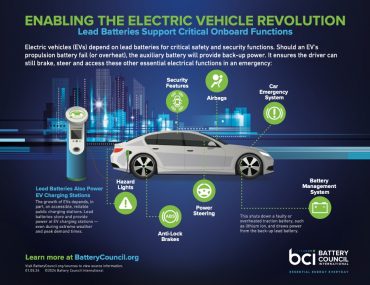
On a global scale, only 1 in 250 cars on the road is electric and comprise just 3% of car sales worldwide, according to Bloomberg New Energy Finance. The recent launch of the all-electric Ford F-150 Lightning has garnered attention since the Ford F-Series has been the top-selling pickup in the industry for 44 consecutive years. A fact that is not well known is that the Lightning, as well as all other electric cars and trucks, contains a lead battery in addition to the electric battery to provide critical safety functions.
As in the U.S., Europe is implementing policies to speed electrification and move from fossil fuels. A shift to electric vehicles (EVs) is viewed as a key step in the transformation.

Our guest blogger, Dr. Christian Rosenkranz, Chair of the Consortium for Battery Innovation and Vice President Industry and Governmental Relations EMEA at Clarios, sets out how lead batteries supporting safety systems in electric vehicles are integral to low-carbon mobility.
We’re featuring Dr. Rosenkranz’s thoughts with our U.S. readers as the information is also true for the U.S.
Europe is at a critical crossroads in its ambitious goals of achieving a climate-neutral EU by 2050. With initiatives driven through the EU Green Deal to decarbonize Europe, one of the central ways in which this will be achieved is through low-emission mobility.
Electric vehicles are at the forefront of discussions around Europe’s low-emission vehicle fleet and the future of the automotive industry.
Batteries are critical for electric vehicles, but not just the ones you hear most often about: lithium-ion batteries. The other critical on-board component for electric vehicles, and indeed the range of lower emission vehicles such hybrid vehicles, are 12V lead auxiliary batteries.
These auxiliary batteries play an essential function for hybrid and electric vehicles and lead batteries offer a number of key strengths in this application in comparison to other technologies.
The 12V auxiliary lead battery provides back up power for safety relevant features such as power steering and brake boosting. But they’re also essential for a vehicle’s comfort features such as radio and sound systems.
In the event of the failure of the high-voltage propulsion lithium-ion battery, the auxiliary lead battery takes over and powers the safety features of the vehicle to enable the car to safety pull over.
As a technology, lead batteries are highly safe and reliable, and it is vital that the safest technology is used in this application.
Current European investments in batteries has focused on the development of new battery technologies that can provide increasing system voltage levels of up to 800V. But this ignores the established 12V lead battery which is backed by an industry with 90 GWh installed production capacity located in Europe.
This mature industry, which collects lead batteries at end-of-life at rates of almost 100% in Europe, is one of the leading examples of circular economy in Europe.
From a production and supply standpoint, lead batteries are domestically produced in Europe for all of the target markets. This independence from global supply structures exists due to the established and well-maintained recycling industry, where almost 80% of material in a new lead battery comes from recycling.
With recent lifecycle analysis of the environmental impact of a vehicle over its lifetime, lead batteries as a technology were shown to have a lower impact compared to other technologies.
Backed by a strong reliability and affordability profile, lead batteries also have wide operational temperature windows compared to li-ion batteries, which intrinsically enhances the operational robustness of the entire system.
The safety record of lead batteries sets it apart from other chemistries and makes it an invaluable technology for Europe’s future low-emission mobility sector.
Through a long history of co-operation with the automotive industry, both the performance and the geometrical dimensions of the 12V lead battery are designed according to well established industry standards. This makes the automotive integration easy for the layout of new xEV platforms.
We are in the age of the battery, and recognition should be given to the essential role different chemistries will play for Europe’s green ambitions. Recognizing and utilizing the strengths of 12V lead batteries, based on their performance, sustainability and safety profiles, will ensure Europe is a leader in the shift to an electric vehicle future.





